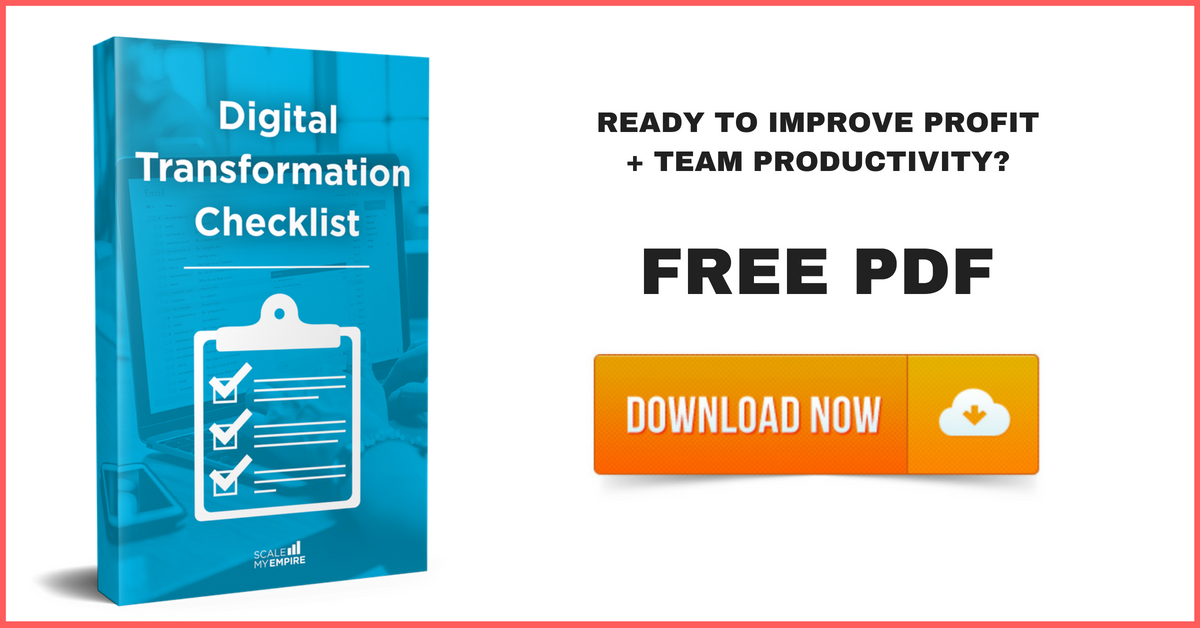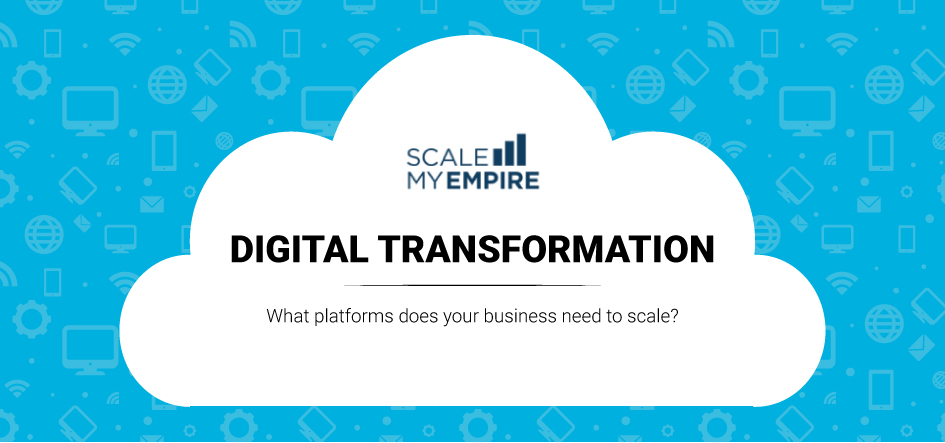
Make the jump without ‘jumping the shark’. In this article we’ll talk about the pitfalls and preparations you need to make before ‘scaling your empire’.
Scalability is your business’s capacity to cope with and even thrive while it is experiencing significant growth. If your business can maintain or even improve productivity, efficiency, and overall performance while expanding, then your business is scalable.
There’s no question here: in order to stay alive and relevant, your business has to be scalable. But, there are inevitable challenges that all businesses go through no matter how adaptable and relevant they remain. And, many of these challenges can cause even a growing business to crash and burn.
If you don’t know where you stand finance-wise and you’re not clear on your growing team’s feelings and commitment, you run the risk of not only losing your environment but big client accounts as well.
These challenges, which we’ll get into in this article, effectively seem as though they’d require you to be working at your business 24/7. If you’re not prepared with the proper systems in place, you’ll be running around putting out fires all day.
This is not why you went into business, right?!
So, what are these most grating challenges and how can you best deal with them?
1. Growing revenue while maintaining profit
Something’s happening! Something that you thought would never happen fast enough.
You and your team have been grinding it out, busting at the seams with innovation, creativity, and sheer burning desire for the past few years, and it’s happening at last.
Your revenue is finally growing at an unexpected and significant rate.
Growing revenue is a study in prioritization #ScaleMyEmpire Click To Tweet
This is obviously a result of a larger clientele, among other things. So, not only is your income growing but so is your team—someone’s got to manage all of the increasing workload.
You might even consider setting up another office interstate to take advantage of all of the new opportunities. Your business is expanding just as you’d hoped.
On paper – mostly your Profit & Loss (P&L) reports – your numbers look solid but there’s a lot of extra time and effort that goes into dealing with growing revenue that you may not have expected.
Cash flow, on the outset, never used to be a problem, especially when your numbers are going up and are showing you to be in the black. Yet handling the cost of that revenue is not a walk in the park for a growing business.
While handling increases in revenue seems like a good problem to have, the sign of a healthy business lies not necessarily in its top line but in its margins.
Related article: Maintaining Margins as You Grow: Why It’s Important and How to Do It

We like this statement from Vinny Antonio which John Hall shares in his Forbes article on the challenges of fast-growing companies,
“It’s almost a full-time job staying on top of who owes you what and who you owe, and then prioritizing those payments. All the while, you’re pushing for more growth, but with that comes additional expenses—most notably, your executive team.”
As we go through the rest of this article, keep in mind a fundamental question on the efficiency required to scale your empire:
Is this system we have in place efficient, productive and competitive for the new, ‘mid tier’ market we are entering? Does our revenue justify the bigger problems that come with the extra money?
These questions may be tougher to answer than you think.
2. Managing an increasingly more complex billing cycle
If you’re expanding your business that usually means your client base is also growing.
This is good—more and more people recognize the value you bring to the table. Some of them even put their own credibility on the line to back you up or refer you to other potential customers in need.
The exponentially growing number of clients can quickly get out of hand, if your client billing system isn’t scaling with your own business growth.
It may be time to chuck your good ol’ trusty spreadsheet for something a bit more sophisticated. A spreadsheet might have been handy on a smaller scale but with business growth comes a definite need for an upgrade.
Don’t take this challenge lightly or put it at the very bottom of your list of priorities. This isn’t simply about having fancy tech or pretty and color-coordinated letterhead.
If you’ve been operating on a system that could handle a dozen or so projects, try and visualize that system incorporating, in turn, a dozen or so clients, each with a handful of projects of their own.
That’s pages and pages of timesheets trying to be lined up with project cost codes, and then you have to work out what needs to be billed. Can your billing system easily assimilate?
With this type of basic system, a bill can be all too easily missed. Sure, you’ll be able to recover it but you’d have to have an awkward conversation with the client next month. And, now your cash balance isn’t so balanced anymore…
Can you see how this kind of inefficiency can be quite costly? Not just in terms of awkward situations but the overhead alone just in trying to bill clients is insane!
Billing automation is the key to solving this.
In a growing business, the types of jobs you take on, the varying schedules of payment and the effort required to generate your client bills can be overwhelming. With a billing automation system you can be billing out your work at the click of a button or on a regular schedule (great if you use retainers for your clients).
Managing your payment terms after the invoice is fired off is just as important.
Again, another process that can be automated is your client billing follow-ups. This not only saves potentially hours of emailing or calling each week, but makes sure no bills fall between the cracks.
Related article: 10 Common Recurring Business Challenges: Learn How to Overcome Them
3. Letting go and empower others to work for you
Now that your business is growing, you have to manage managers. It’s become practically impossible to oversee, let alone have a hand in, every part of every project.
There’s no way of getting around it: there are going to be some things that you’ll have to let go of and trust others to handle for you.
It’s time to let go of your inner control freak (to some degree)!
Alternatively, your business is most likely experiencing compound growth, creating more tasks to manage and people to coordinate. So, it’s highly unlikely that everyone will know exactly what to do in every situation, just the way you like it.
On the one hand, you can’t manage everyone in and every aspect of your business. And, on the other hand, everyone will have their own way of doing things, their personal system to follow.
Back when you had a finger to every pulse of your more modest business, you could easily monitor everything, even if you weren’t directly involved in every stage of a project.
But, now the challenge is that there’s no set methodology, no basic template, no single go-to system for everyone to follow.
And, with the exponential growth your client list is seeing, you’ll have an equally exponential variety of demands and/or requirements.
You might begin to see things fall through the cracks like work being incomplete or released before going through the proper processes of editing and approval. This inevitably leads to some clients being disappointed.
Losing credibility at this stage of the business game would definitely be a heavy blow and a tricky (but not impossible!) defeat to come back from.
You have to systemise your business to empower others to work for you, in the way you envision your business should serve your customers.
Begin to brainstorm on the kind of overall system you can put in place to help coordinate your various projects with the inevitable and varying methodologies of your people.
Think about the customer experience you want to create – what are all the steps required for someone else to recreate this without you being involved.
With that, how do we create accountability from every employee at every stage of a process?
It’s not just great process that you need, but people as well.
Putting in the time and capital to hiring a good management team is anything but risky.
Find people that can not only manage the work of your business but also effectively take your quantity and turn it into quality. This leaves you free time to work on your business and not in your business.
And, trust your managers—let them do their job. Not only would it be confusing to your employees if you were to constantly “go over” your management’s heads but you’re not allowing your employees to instill trust in your management. This makes it difficult for your management to feel like they can, in turn, trust you.
Related article: 5 MUST HAVE metrics to measure the success of your services business
4. Forecasting to get visibility over your growing Empire
As a growing business getting clear visibility over your business’s cash flow is becoming frustratingly difficult.
According to your revenue and even your Profit and Loss sheets you’re in the black—great!
But, understanding how your cash is actually flowing (i.e. What’s coming, and when? What’s going out, and when?) is key to continuously making the right spending decisions.
You can get a handle on this by studying your project profitability ratios. Knowing the schedule of costs to revenue is fundamental in order to stably scale your empire.
If you can understand what works for making your operations not only functional but efficient, you can learn where to invest most of your time and effort and even where you can afford to cut back.
Despite growth, you can continue to invest in your business in a way that is modest for your pockets but effective in production. This keeps your margins nice and wide–a truly healthy and profitable business.
Related article: Five Ways to Boost Your Business’s Ability to Stay Competitive
Remember when we talked about systems and processes?
Well, the downfalls of not having a proper system in place to manage every project at all levels will definitely show up on your accounting ledgers, despite the positive feedback from your P&L.
Now, if you’re running a growing enterprise, then you have most definitely set up some company metrics for monitoring projects already. But, again, you have to gather all of the data from each individual working on a project.
Chances are they have their separate way of accumulating data and using your metrics. Deciphering all of that from every person in each project is, no doubt, time-consuming and strenuous (depending on how easy it is for you to decode your people’s personal systems in the first place).
After all of that, your data may not even be all that accurate. With growth comes complexity and this is definitely showing up on your balance sheets, making it difficult to even try any kind of financial forecasting.
You don’t need visibility merely for visibility sake.
Instead, you need visibility because knowing exactly what’s going on in your business, when it’s going on, and, most significantly, why is the key to continued growth and success.
Visibility is your ability to see what lies ahead for your business. Forecasting, then, is your ability to call some pretty important shots based on that visibility.
In other words, if you want to have continued success, then what you see for the future of your business better be as accurate as it can be.
Don’t merely rely on the P&L. Rely also on other accounting documents like your balance sheet, and your income and cash flow statements.
These can help you to determine the cost of operations for individual projects and the business as a whole as as well as profits made.
After determining the basic “flow” of your operations, you’ll then be able to determine, for your business, a basic, overall system that can truly help to crack down on that project profitability factor we talked about earlier.
To help make sense of the numbers make sure that you’ve got experts on your team whether it’s an outsourced Chief Financial Officer, or a trusted accountant and bookkeeper.
Knowing these numbers can help you put in place newer and better metrics to help you better scale your empire.
5. Productivity of a Growing Team
When you are growing your team of managers and employees, the last thing you want to be thinking about is overhead. But, it does take quite a bit more resources to manage your growing business.
There’s a lot more activity—a nice way of saying problems—where accounts, timesheets, payroll, and all of the other expenses are concerned.
You absolutely need someone to manage the more complex financial requirements and HR side of your operation. This calls for a lot of extra administrative work, so you’ll likely need not just accountants but admin staff as well.
With this growing team of superstars comes a growing list of meetings, conflicts, levels of decision making – all which impact a key metric of your business: Team Productivity.
This factor alone can change the tide for all of the other challenges on this list. How so?
When you first started with your small team, people, all with different strengths and backgrounds, worked together cohesively while valuing and respecting sound and already-established principles to attain your business goals.
But, if you’re just now experiencing the growth of not only your revenue but your team as well, you may be stepping out into new territory and don’t know how to keep that synergistic vibe going.
In fact, you may feel like that hustle, that euphoria of the aligned team is turning into a daily grind.
There are two important parts to building a high performing, productive team: systems and culture.
We just talked about systems and how important they are to empowering your team to work for you.
The second (and no less important) way to keep team productivity buzzing and the culture at your office alive is to stick to your principles and remember the values your company was founded on.
In a recent interview Virgin CEO Richard Branson shared the following:
“My philosophy has always been, if you can put staff first, your customer second and shareholders third, effectively, in the end, the shareholders do well, the customers do better, and yourself are happy.”
Makes sense, right?
Well, people tend to work a lot harder and devote not only more time and effort but also heart and passion into what they’re doing when they know why they’re doing it.
Why did you found the very business you’re working to keep thriving in the first place?
If you hire people based on the shared values and common goals they have with the company then it pretty much doesn’t matter what kind of work you throw their way.
If you treat people with the same respect and trust that you expect then you’ll find it quite easy to ask your employees for just a little bit more.
Aligning what you believe with what you say and do is the quickest and most organic way to create harmony within your business.
Align what you believe with what you say and do. You’ll perpetuate harmony in your business Click To Tweet
Prepare yourself for success
Transitioning from small to medium is not going to be easy but it doesn’t have to be burdensome.
While growing revenue, team size, and client accounts will undoubtedly cause you and your team to stretch itself thin for a little while, you’ll see the benefits of a constantly growing empire.
Be prepared for that growth by constantly revising your system, making sure it stays efficient, productive, and competitive. This will assure that your margins stay healthily wide.
Also, get your system automated with client billing as well as follow-ups. With automation, you won’t have to go through the chaos of getting the right invoices to the right people on time. And, they’re now less likely to fall through the cracks, while sparing you the time you would’ve otherwise spent on the phone or sending emails.
You can also prepare for growth by trusting your managers to do what you’ve trained them to do. Let go of some of that control, and trust your accountability system to work!
Don’t forget to gain clearer visibility over your cash flow by constantly studying the various balance sheets for your numbers. Project profitability determines whether or not you’ll ultimately be profitable at the end of the day.
Lastly and most importantly, remember why you’ve decided to be in business for yourself. It’s much easier to lead a team with shared values and a common goal.
Prepare yourself by having your founding principles, an efficient system, and the right priorities in place. Make sure your vision is clear and that your team values and respects it.
Be prepared for the growth that is about to come your way!
Work on your business, not in your business #ScaleMyEmpire Click To Tweet
Looking for an in-depth and step-by-step guide to scaling your empire? Download our free digital transformation checklist to assess your company’s technological readiness to truly transform into a digital enterprise.






